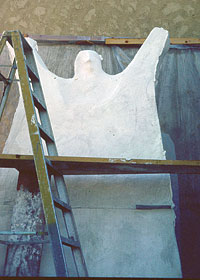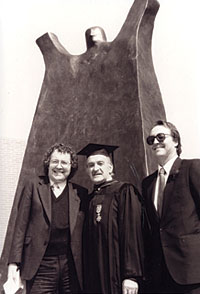Enormous Luther
By Donald DeMars '64
In front of the Pearson Library and Preus-Brandt Forum stands an abstract sculpture of Martin Luther, the 16th century rebel monk whose interpretation of faith and very name were incorporated into the name of this university by the religious organizations that founded it. Since its inception, this sculpture, mainly due to its form, has been the center of much discussion, controversy and interpretation.
The History
The Luther Statue (Enormous Luther) was a gift to the Cal Lutheran community from the members of the first graduating class, the Class of 1964. The idea for the gift originated with Jim Gulbranson, a member of the class, and Sir Bernardus Weber, the school's first sculpture teacher who was commissioned by the class to create and develop the work. Professor Weber was originally from the Netherlands where his works had earned him a knighthood from Queen Wilhelmina.
When Weber presented the concept and small 6-inch model representing the sculpture to the senior class at the graduation festivities, he explained that the concept, form and massing grew out of his memories and impressions of Luther from his early art academy years in Holland. The one word that described his impression of Luther that had stayed with him from those early years, he said, was... "enormous!"
Luther's personal integrity, commitment to truth, radically new interpretation of faith, and a grim willingness and determination to do the dirty work of his age culminated in the protestant Reformation and the rending of Western Christendom. Luther was like an enormous wall between the Middle Ages with its hierarchical dogma and the enlightenment of the Renaissance that offered a clearer and more refined personal theology for the modern world.
For Luther, God's steadfast grace and love were to be understood as a gift, centered on the cross, calling people to understand meaningful life as service to others through compassion and hopefulness.
When presented with the model and concept, members of the first graduating class were not quite sure how to react; we were certainly not expecting what he presented. Although the class had never talked about it, I think we were all expecting a more realistic depiction of Luther. Weber explained that this was not meant to be a realistic rendition, but a symbol of Luther's time, place and posture in history: old forms were being questioned and new forms were emerging.
After graduation our class moved on toward pursuing "life after Cal Lu," all the time vowing to complete the statue at some time in the future.
Finding a vocation

Receiving a gift scholarship to further my education through travel following graduation, I went to Europe with the intent of going to Wittenberg to Luther's Castle Church where there was purported to be a statue of Luther. Without a proper "Tourist Visa" to visit East Germany, I crossed through "Checkpoint Charlie" in Berlin with only a Transit Visa, which required me to stay on the Autobahn expressway until I reached Dresden where I had to report to the East German police.
I was so intent on getting to Wittenberg that I secretly got off the Autobahn, found my way to Wittenberg, got a great picture of Luther's statue, and went on to Dresden, later returning home to complete seminary and pursue the dream of finishing the statue. Little did I realize how much further Martin Luther was to influence my own life.
In my second year at Pacific Lutheran Theological Seminary, I took a course on Luther from the noted scholar Dr. Robert Goeser. A pre-seminary student at Cal Lutheran, I was now struggling with the decision of whether to remain in seminary or leave to follow my "artistic leanings" and love of art and design.
Dr. Goeser gave me a small treatise to read that Luther had written in the 16th century; it was called "Vocation." In this short work, Luther compared the scrubwoman and the priest, basically describing the priest as going through his tasks virtually by rote with no feeling while the scrub woman, although burdened with hard physical labor, took pride in the end product of her efforts and displayed great joy in doing a good job.
Luther ended the treatise by saying, "You are meant to do (and the German is not perfectly translated in English) ... that which 'tickles you on the inside.' Find that tickle and dedicate yourself to it; that is what you were meant to do." The very day that I read this work is the day that I left seminary. I knew exactly what "tickled me on the inside." I returned to school, completed a graduate degree in art history, became licensed in architecture and interior design, and opened my own firm in 1975.
A promise fulfilled
It took roughly 20 years for me to realize the implications of my decision to leave seminary and pursue design and art, especially as this related to bringing the gift of the '64 graduating class into reality. As the class president, it was my responsibility to keep the class focused, help leverage the funds, pursue the process of developing the statue, and look for an environment on campus in which to place it.
The opportunity came in 1984 when I received a call from President Jerry Miller. The new campus library had been announced and designed with a firm budget of $3.5 million. However, the construction bids had come in roughly $3 million over budget. I was asked to analyze the situation and report my findings and recommendations to the Board of Regents.
I presented a new design to the Board, resized and reoriented the placement of the library to its present location, and created a North/South campus axis and promenade leading to a small plaza in front of the library. At last we had found a place for the statue.
Ben Weber had originally conceived the statue as an enormous bronze figure 12- to 16-feet high, presented on a walk-up pedestal. By the time the Class of '64 had raised the funds necessary to build such a monumental statement, Weber had reached an age that made it difficult for him to physically perform the work. Therefore, my brother David, a professional sculptor who had also studied under Weber at Cal Lutheran, was commissioned to transform the small 6-inch model and concept into its present size and form.
A skeletal armature of wood and steel was first built. More than 1,000 pounds of clay was then modeled to create the finished form. A plaster impression was made, and this casting was shipped in massive pieces out to the bronze foundry in Sun City, Calif. The individual parts were poured in bronze and welded together. David then deburred, ground and burnished the finished statue. It was shipped to campus on a large flatbed truck completely wrapped in the drape that would keep it hidden until its unveiling. Finally, a large crane hoisted the 5,000-pound statue onto the pedestal where it sat until its unveiling and dedication in October 1986.
The form as symbol

The one thing that everyone agrees on when discussing art is that everyone has an opinion. Creativity seems to engage our "aesthetic sensibilities" and often challenges our accustomed ways of looking at things. Our instinct for order and our need to understand can be challenged by conceptual or abstract art; it pushes the boundaries of what we count as art.
Conceptual or abstract art can nevertheless communicate something underneath appearances perhaps more significant of reality than any exact resemblance of reality might be. As Cézanne said of his own work, "I have not tried to reproduce nature, I have simply represented it."
Observing the statue's shape and posture on site, the "enormous" block-like form is reminiscent of a barrier or barricade. The form is narrower at the shoulders and cascades down to a wider base, as in a monk's robe. The arms are truncated, suggesting abruptness, and raised in defiance as if saying, "Stop!" The form is leaning back, as if pushed by the force it is standing against. The face and head appear to represent something inside that is trying to push up, out and through the outer surface containing it.
The accepted definition of symbolism is one thing standing for another, tacitly understood to mean not by exact resemblance. Thus this statue is a symbol; a symbolic expression by which Luther the man and his moment are recreated and reenacted. Why this sculpture took the form it did is indeed complex and hidden in the personality of Ben Weber and his personal artistic expression; it was and is subjective, instinctive and subconscious.
Martin Luther was a man of his time, but this symbol of what Luther stood for is a strong and vital statement of what CLU continues to stand for in our present context. The official seal of our institution shows that our school was founded on "Love of Christ, Truth, and Freedom."
Luther's thoughts, beliefs and actions were based on faith, reason, conscience, academic discussion and a commitment to truth. What could be a better foundation for students seeking a liberal education in our modern world?
President of the Class of '64, Donald DeMars, IIDA, has specialized since 1975 in the planning, design and financial positioning of health/fitness/sports and mixed-use facilities throughout the world. He is the Chairman and CEO of Donald DeMars International, an internationally recognized design and development consulting firm; President of the California Dreams Corporation, a nonprofit, philanthropic organization; and is Managing Director of Power of Human Energy, a corporation creating capital resources for developing countries.